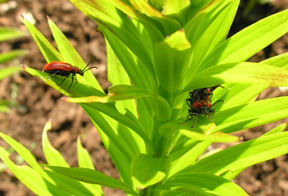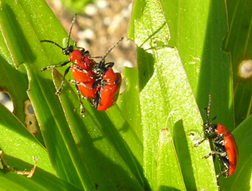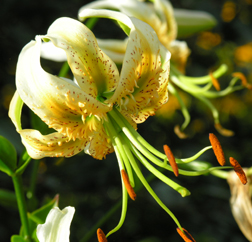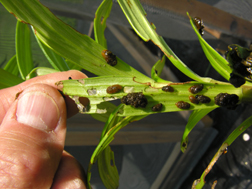Bulletin #2450, Lily Leaf Beetle
 Developed by Philip A. Stack, collaborating researcher, Hampden, Maine; with Professor Eleanor Groden and Extension Professor Lois Berg Stack.
Developed by Philip A. Stack, collaborating researcher, Hampden, Maine; with Professor Eleanor Groden and Extension Professor Lois Berg Stack.
For information about UMaine Extension programs and resources, visit extension.umaine.edu.
Find more of our publications and books at extension.umaine.edu/publications/.
Lilies (“true lilies”, plants of the genus Lilium) are an important source of color in summer and early fall perennial gardens. However, in recent years, home and commercial gardeners have been plagued by a bright red beetle whose feeding causes extensive damage to many susceptible lily species and hybrids. This very serious pest is the lily leaf beetle (LLB), Lilioceris lilii. LLB, a native insect of Europe, has become a widespread pest of native and exotic lilies throughout New England, where it was first reported in 1997. This beetle threatens the use of garden lilies in our region.
In addition to Maine’s native lilies, Canada lily and wood lily, a myriad of hardy hybrids are commercially available. They range in height from 1 to 5 feet and produce flowers of most colors except blue. Most garden hybrids belong to one of two groups: Asiatic hybrid lilies are earliest to flower and have small, narrow leaves, while Oriental hybrids are taller, with wider, more succulent leaves. All have mild to heavy fragrance and most have a long bloom period.
LLB lays eggs and completes its life cycle only on true lilies and fritillarias, LLB adults may feed on and cause minor damage to a few other herbaceous plants such as Solomon’s seal and flowering tobacco, but they do not reproduce on these plants. LLB adults and larvae feed on leaves, stems, flower buds, and flowers. The defoliation reduces plant vigor and flowering, greatly diminishing the aesthetic quality of plants. These insects do not feed on daylilies.
Lilies are susceptible to various other pests. Slugs and snails feed on lily leaves and flowers and are especially damaging in rainy years. Gray mold (Botrytis) is a plant disease that infects flowers and leaves and is best controlled by providing good air circulation among plants. Damage by LLB is proving more difficult to manage than these other occasional pest problems.
Biology of Lily Leaf Beetles
LLB adults overwinter in plant debris or soil either near host plants or some distance away. They prefer hibernation sites that are cool, shaded, and moist. Adults emerge from very early spring through June. They feed and mate throughout this period. They are strong fliers and disperse over long distances. There is one generation per year.
LLB adults are about one-quarter-inch long and bright scarlet. Their head, antennae, legs, and underside are black. Adults emit a squeak if disturbed or squeezed, to deter predators.
Females lay orange eggs in an irregular line on the undersides of leaves and on flower buds and open flowers. LLB larvae emerge from eggs and pass through four life stages, growing larger as they molt. They cover themselves in their own excrement, called a fecal shield. This moist black material acts as a defense mechanism against predator species.
Nonchemical Control of Lily Leaf Beetles
Hand-picking adults, eggs, and larvae is an effective means of reducing damage. It’s important to begin scouting for the emergence of adults in April and destroy any that you see. As spring progresses, check the undersides of leaves for orange egg masses and destroy them as well. Remove young larvae from leaves as they develop. Wear a tight-fitting rubber glove if you want to avoid directly touching the eggs or larvae. Make this practice a regular routine throughout the summer months, as it is a very effective control tactic.
Chemical Control of Lily Leaf Beetles
Neem, an extract of the neem tree (Azadirachta indica), is the active ingredient in the organic insecticides Turplex, Azatin EC, Margosan-O, Align, and Bio-Neem. Neem is most effective on first-stage, very young LLB larvae, and should be applied every five to seven days after eggs begin to hatch. The systemic synthetic insecticide imidacloprid (Merit) also provides effective control when applied to the soil in early spring. Malathion is an effective chemical spray for adults and larvae. Follow the directions on all pesticide labels closely.
Promising Research on Lily Leaf Beetles
Entomologists at the University of Rhode Island have identified a group of parasitic wasps that are potentially effective biological control agents against LLB. Their research is ongoing and these wasps are not yet commercially available.
We have conducted research at the University of Maine to identify lilies that offer resistance to LLB. We have found that certain lily species limit the survival of LLB eggs and larvae and thereby reduce subsequent damage to the plants. Our research indicates that Asiatic hybrids are the most susceptible lilies, while certain Oriental lilies and other hybrids may provide some resistance. To date, the three most resistant lilies in our tests are Lilium henryi ‘Madame Butterfly’, Lilium speciosum ‘Uchida’, and Lilium ‘Black Beauty’.
- Mating LLB Adults on Oriental Lily
- Lilium ‘Madame Butterfly’
- LLB Larvae and LLB Damage
Acknowledgments
Research funding from the University of Maine Agricultural Center and USDA IPM Partnership Grants.
Photos by Philip A. Stack and Lois Berg Stack.
Information in this publication is provided purely for educational purposes. No responsibility is assumed for any problems associated with the use of products or services mentioned. No endorsement of products or companies is intended, nor is criticism of unnamed products or companies implied.
© 2009
Call 800.287.0274 (in Maine), or 207.581.3188, for information on publications and program offerings from University of Maine Cooperative Extension, or visit extension.umaine.edu.
The University of Maine is an EEO/AA employer, and does not discriminate on the grounds of race, color, religion, sex, sexual orientation, transgender status, gender expression, national origin, citizenship status, age, disability, genetic information or veteran’s status in employment, education, and all other programs and activities. The following person has been designated to handle inquiries regarding non-discrimination policies: Sarah E. Harebo, Director of Equal Opportunity, 101 North Stevens Hall, University of Maine, Orono, ME 04469-5754, 207.581.1226, TTY 711 (Maine Relay System).




